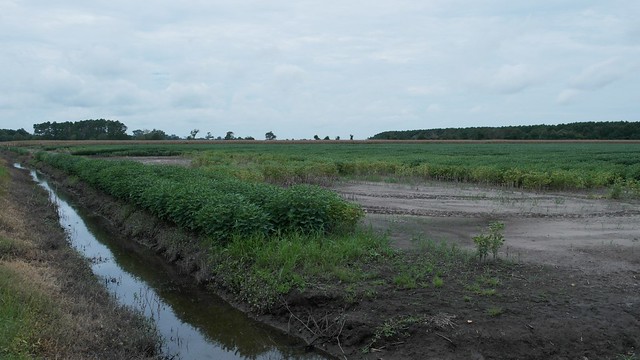
Trees and crops are experiencing stress, productivity loss and even death in coastal areas due to saltwater intrusion and salinization. For example, Somerset County, Maryland has been losing farmland to salt marsh migration at a rate of 100 acres per year over the last 10 years, and that amount is expected to increase significantly in the next few decades.
In an effort to understand and address saltwater impacts on coastal forest and farm productivity, the Southeast Climate Hub organized a workshop on October 8, 2019 in Goldsboro, NC to discuss the current state of knowledge on saltwater intrusion, its impacts, and adaptation options. This was the first workshop by the Southeast Climate Hub to explore this topic. The workshop brought together forty researchers and professional experts from the private and public sectors from Virginia, North Carolina and South Carolina to share their research and knowledge about saltwater issues.
The causes of salinization, impacts, and effectiveness of some adaptation methods compared to others are well known. Salinization can be caused by a range of factors such as sea level rise, storms and tides, drought, water management, and water source connectivity. We also know that salinization can lead to coastal forest loss, crop yield declines, release of nutrients from the soil, and movement of marshes inland. Available adaptation options to address salinization include growing alternative crops, developing salt tolerant crops, planting salt tolerant plant buffers, applying for a wetland easement or applying gypsum to affected soils. However, some of these adaption methods have shown more success than others. For example; the application of gypsum, a moderately water soluble and calcium rich sulfate mineral, is an adaptation option dependent on sufficient leaching through drainage and freshwater availability to be successful.
There continues to be a lack of knowledge on the economic costs and benefits associated with adaptation options. Depending on the region, these economic factors can vary, which makes the decision to use new management practices site-specific. While there are many theoretical solutions to saltwater issues, it will take time to understand how these solutions perform in practice and to identify markets for alternative crops if that adaptation method is to be implemented.
The discussions from this workshop will be used to structure additional workshops with stakeholders and to create practical guidance for land managers to address saltwater related issues on their property. While we don’t have all the answers yet, we can still assess the risks of saltwater intrusion, and make them better understood. Understanding how water is interacting with the landscape is the first step in making informed management decisions. To learn more, you can view the Southeast Climate Hub’s factsheet on salinity and salinization impacts (PDF, 1.4 MB).

